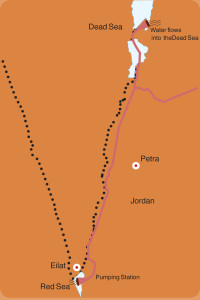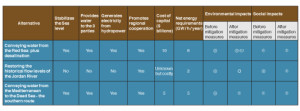Doing Business in the Middle East:
Red Sea – Dead Sea Water Conveyor Project: Project outline, assessments and potential benefits to the Palestinian Territory – By Palestine Economic Policy Research Institute (MAS)
Red Sea – Dead Sea Water Conveyor Project: Background
The Red Sea-Dead Sea Conveyor is a project to construct an 180-kilometer tunnel (and pipeline within) running from the Gulf of Aqaba on the Red Sea in the south to the Dead Sea in the north. It is a joint venture between Jordan, Palestine and Israel. The project mainly seeks to stop environmental degradation in the Dead Sea, provide the beneficiaries with fresh water, and produce the hydroelectric power needed to operate the pumping and water desalination stations. The planners see the project as a symbol of peace between Arab states and Israel. The project will require $11 billion in capital. The parties are looking forward to raising capital from international donation and from the three beneficiary countries.
Environmental degradation of the Dead Sea
The Dead Sea is shrinking at an annual rate of 1 metre (1m), down from 394m below sea level in the 1960s to 423m below sea level in 2012, reducing the total area of the Sea by about one third (from 950 square km to 637 square km). The main reason behind this decline is attributed to the dramatic shrinkage in the flow of the water of the Jordan River, which is, in turn, engendered by the exploitation of the water of the river and its tributaries, mainly by Israel. Israel has diverted a number of the river’s tributaries to grow some exotic crops that need large amounts of water, and has re-routed a number of naturally flowing valleys (in which the rain water pours before flowing into the sea) to the Jewish settlements in the West Bank. The total mass of water held back constitutes 90% of the Dead Sea’s resources. What’s more, the water of the Dead Sea is being drained by the Israeli and Jordanian factories built on its shores.
Economic losses
The environmental degradation has occasioned significant economic losses, particularly the significant decline in the tourism sector, the incurred losses by factories, the enormous negative effects on the agricultural sector in the areas of the Jordan Valley and the damage in the region infrastructure (represented by 3000 sinkholes around the area).
Water Shortage
The region is at a disadvantage in terms of the dearth of water resources, which makes it imperative for the three parties to search for new sources to meet the needs of the growing demand for water; this is especially in light of the widening gap between the available resources and the needs of population growth.
In addition, the current allocations of the Jordan River’s waters are not consistent with previous agreement and negotiations. Specifically, Palestinians’ use of the Jordan River water is non-existent due to the water quality degradation and Israeli military closure.
Different Perspectives
Proponents of the Red-Dead project see in it the best way to address environmental challenges in the Dead Sea area; provide the region with fresh water; create new jobs; and help in turning large areas of the desert to populated, tourist destinations. Above all, the project will promote the Arab-Israeli co-operation and enhance the opportunities for peace. On the other hand, the opponents of the project believe that it could induce adverse effects on the environment, and that the project does not provide practical solutions to the problem of the shortage of drinking water. They also argue that the envisioned scope of the project’s political role is exaggerated. Accordingly, they propose an alternative solution: a restoration of the Jordan River to its natural flow, reducing the exploitation of the water for industrial purposes, and rationing water consumption
Opponents focus on the potential adversary environmental effects, including the damage to the natural unique system of the Dead Sea, and the water’s admixture (which is a propitious ambiance for the emergence of algae and calcareous sediments), which eventually changes the colour of water. In addition, groundwater in the Wadi Araba could be contaminated if a pipeline is damaged, which is quite possible in an area of frequent earthquake activity.
The Proposed Conduit/Conveyor
The project involves setting up the largest pumping station in the world between Aqaba and Eilat, as well as a desalination plant in the farthest southern side of the Dead Sea. This station will annually pump 1.9 billion m3 of water from the Red Sea. Half of the pumped water will be subject to desalination, and the other half will be pumped directly into the Dead Sea.
The political dimension
Although the project is supposed to be a joint venture between three equal partners, the repeated statements of Israel often sought to keep the Palestinians out. The Palestinian Authority, in turn, is eager to be an equal party to the project.
Building peace between Arabs and Israel is not a new idea. There had been several proposals designed to strengthen Arab – Israeli cooperation through the development and distribution of scarce water resources. Back in the mid 1950s, there was the American scheme ‘Johnston’ which was intended to divide the water of the Jordan River and Yarmouk River between Syria, Lebanon, Jordan and Israel. According to studies conducted at the time, the annual amount of water that could have been transferred was estimated to be about 284 million m3, and the amount of electricity that could have been produced was estimated at 218 million kilowatt / hour. The cost of the project was projected at $121 million (prices of 1953). However, Syria and Lebanon rejected the project because, according to them, it would have meant an implicit recognition of the state of Israel. The efforts of this proposal were entirely thwarted after the 1967 war and Israel’s seizure of the Golan Heights.
Recourse to the World Bank
In May 2005, the three beneficiary parties dispatched a letter to the World Bank asking it to conduct preliminary studies for this huge project and coordinate donor funding. Seeing that the proposed project has developmental dimensions, the World Bank agreed to conduct these studies.
The World Bank studies
The World Bank set up a multi-donor trust fund of eight countries (France, Greece, Italy, Japan, South Korea, the Netherlands, Sweden, and the United States) to finance the preliminary studies. Further, a technical team (of 4 representatives from each of the three parties in addition to representatives from the World Bank) was formed to oversee the completion of the studies. World-renown experts were assigned the task of conducting the studies. They concluded three major goals:
- 1. Saving the Dead Sea from environmental degradation.
- 2. Desalinating water and / or generating hydroelectric power for the benefit of Jordan, Israel and Palestine.
- 3. Creating a symbol of peace in the Middle East.
Below, we summarize and present some results of the studies.
The feasibility study tested three scenarios. The first is ‘No-Project’, leaving the current situation intact. In this case, the region will incur massive economic losses estimated at about $ 2.9 billion, and the shrinking of the Dead Sea to -550 m below sea level over the next 150 years. In the second scenario, only the first objective of the project (saving the sea) has been tested (without considering generating power or distilling water). In this case, the project will raise the water level to -428 m. This requires the pumping of 1.2 billion m3 of water annually. The third scenario (which involves all the objectives of the project) requires annual pumping of 1.9 billion m3 of water, and will secure a stable level of -416, and provide 850 million m3 of fresh water. The costs of the project, accordingly, will total $10 billion (excluding the cost of transferring water to Palestine and Israel), and the domestic revenue will grow by 21.5% compared with the second scenario. In the latter scenario, 350 million m3 of water will be produced, and this figure will rise to 850 million m3 in 2060. The studies corroborated that the water needs in Jordan were estimated based on serious studies by the Jordanian party, while the Palestinian and Israeli parties were not as serious as the Jordanian party. Therefore, the Palestinian side provided an arbitrary figure of needs (only 60 million m3).
This study tested about 20 alternatives of the Red-Dead Project according to five criteria: achieving stability in the Dead Sea or reviving it, making available a new source of drinking water to be shared in the region, enhancing cooperation between beneficiary parties, construction and operating costs and potential environmental and social impacts.
Examined alternatives cover a large number of varying projects, ranging from restituting water sources that were flowing into the Jordan River, to desalinating and conveying water from the Mediterranean to the Jordan River or directly to the Dead Sea, to transferring water from Turkey and from the Euphrates River.
The study sought to examine and evaluate the positive and negative sides of each alternative, and determine the cost and extent of its capacity to achieve the above objectives with relation to the main project (Red Sea – Dead Sea).
The report does not give recommendation as to what alternative is considered more feasible. However, it highlights that the use of water from Lake Tiberias, or through desalination plants, or from any other natural resources for the purpose of stabilizing the Dead Sea, is not considered among the strategies acceptable nor is applicable, as long as the three parties endure a chronic shortage of safe potable water. On the other hand, the report outlines that transferring water from the Mediterranean to Lake Tiberias or to the Dead Sea is fraught with adversary effects on the natural main underground water aquifer, let alone the impact on the highly-populated areas.
Table 1 compares three alternatives: (Restituting the historical flow levels of the Jordan River, Conveying water from the Red Sea, and Conveying water from the Mediterranean). The Table illustrates that Conveying water from the Red Sea, and Conveying water from the Mediterranean would fulfill the goals, while Restituting the historical flow levels of the Jordan River wouldn’t achieve these goals. The Table also shows the environmental and social impacts of each project before and after mitigation measures.
In short, the study concludes that only two alternatives (conveying water from the Mediterranean to the Dead Sea with power generation and water desalination, and conveying water from the Red Sea to the Dead with power generation and water desalination) can meet the five requirements. The analysis shows that the cost of desalinating water in the Mediterranean conveyor is by far lower than in the Red Sea conveyor
The Social and Environmental Assessment
The study addresses associated potential environmental and social problems and states the most prominent challenge is the damage to the unique natural system of the Dead Sea, due to mixing its water with the Red Sea water, or brines created from the process of desalinating Red Sea water.
The report examined the alternatives outlined in the feasibility study and concluded that there are eight aspects of high environmental and social risks. Accordingly, the study concluded that, from an environmental- social perspective, the alternatives that have been analysed in the feasibility study cannot adequately reduce the risks.
The Palestinian Perspective
The World Bank report clearly indicates that degradation of the Dead Sea is not a natural disaster but is a result of the dramatic shrinkage in the flow of the water of the Jordan River (that flows into the Dead sea), which is engendered by the exploitation of the water of the river and its tributaries, mainly by Israel. The Palestinian position supports the restitution of the historical flow levels of the Jordan River, whereas the water shortage issue could be solved by desalination of the Red Sea water, despite the sceptical view of the World Bank reports, which states that restituting the historical flows level of the Jordan River c






